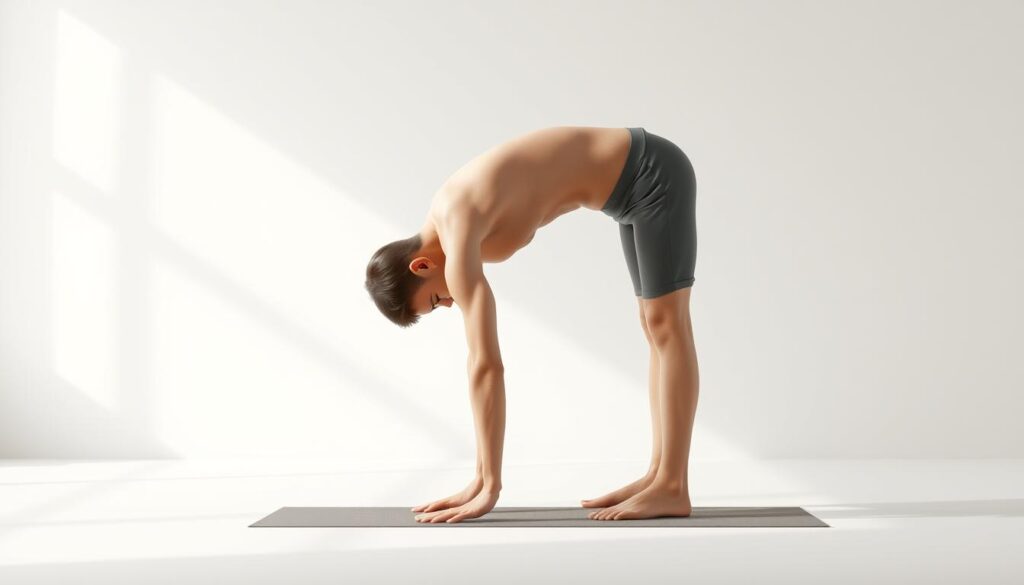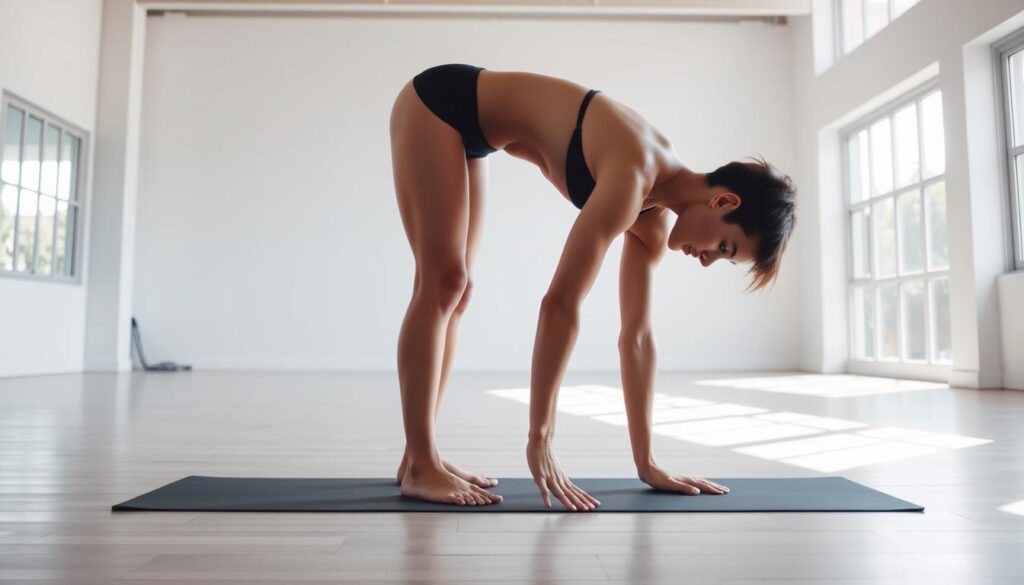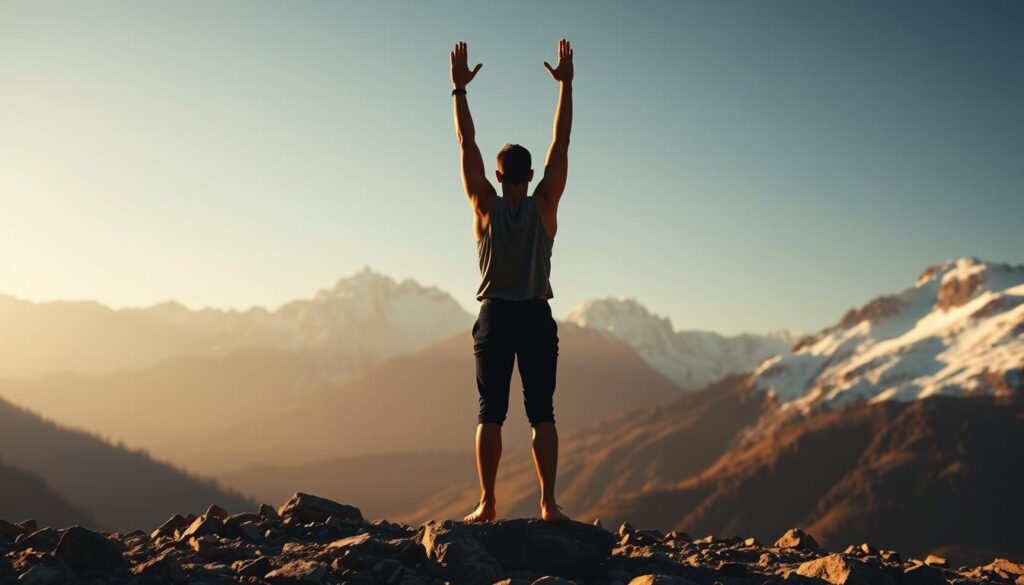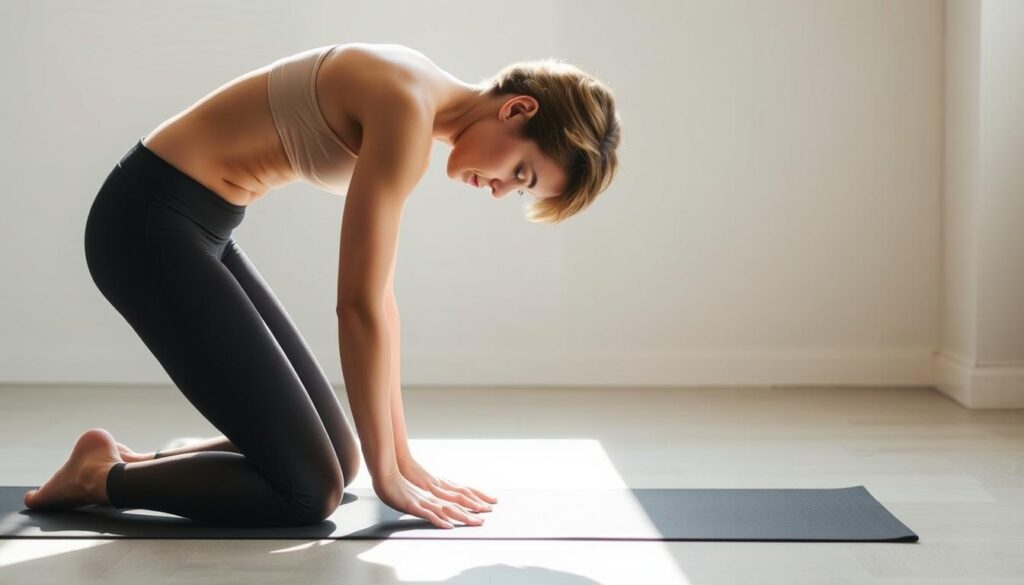
Imagine one simple move that brings deep relaxation and surprising strength. This is what Uttanasana, an ancient yoga pose, offers.
Uttanasana is a key movement in yoga. Teachers all over the world use it in many sequences. It’s found in everything from energizing Sun Salutations to calming cool-down routines.
This pose has a special quality. It calms the nervous system while strengthening the legs and core. Beginners find it easy, while more experienced yogis discover new levels with each practice.
This detailed look shows why Uttanasana is essential for everyone. It’s great as a transitional movement or practiced alone. Its benefits go far beyond the yoga mat.
Key Takeaways
- Uttanasana combines restorative and strengthening benefits in one movement
- This asana appears in multiple yoga sequences, from beginner to advanced levels
- The pose serves both as a standalone practice and a transitional movement
- Teachers consistently incorporate this fold due to its versatility and accessibility
- Regular practice offers benefits that extend beyond physical flexibility
- Both beginners and experienced practitioners can adapt this pose to their needs
Understanding the Yoga Standing Forward Bend Pose
Exploring Uttanasana reveals its deep cultural roots and the key body mechanics. This yoga pose is both a physical workout and a meditation. It connects movement and stillness in yoga.
Those who master this pose enjoy many physical and mental perks. It works on several body systems at once. It’s a mindful way to improve overall wellness.

Sanskrit Origins and Meaning of Uttanasana
The name Uttanasana comes from Sanskrit. “Ut” means “intense” or “powerful,” and “tan” is “to stretch” or “to extend.” “Asana” means a seated posture.
This name shows the pose’s intense stretching and spiritual growth. Ancient yogis saw it as a way to deeply change body and mind.
Anatomical Focus: Spine, Hamstrings, and Pelvis
The pose focuses on three main body areas. The spine flexes, moving each vertebra into the fold. This improves spinal mobility and eases back tension.
The hamstrings stretch deeply as the body folds. These muscles, at the back of the thighs, often get tight from daily life. The pelvis is the hinge, tilting forward to start the fold.
The muscles from the back of the legs to the back work together. This teamwork balances and stabilizes the movement.
Role in Traditional Yoga Sequences
Uttanasana is common in traditional yoga practice sequences, like Sun Salutations. It prepares for and follows backbends. It’s a key pose in these flowing sequences.
Classic Sanskrit texts see it as a bridge between standing and seated poses. It helps shift energy inward while keeping the body active. It’s a moment for reflection in active sequences.
This pose calms the nervous system between harder poses. It encourages a meditative state while offering physical benefits. Its value in yoga sessions is immense.
Step-by-Step Technique for Standing Forward Fold
The standing forward fold technique starts with a strong foundation. It involves paying attention to each movement step. Knowing the anatomy behind each step is key to safety and success.
This pose requires coordination between breath, movement, and alignment. Each part works together for a smooth transition from standing to folding. Here are the steps to master this basic yoga pose.
Starting from Mountain Pose
Mountain pose is the base for all standing forward folds. Start with feet hip-width apart. Make sure your weight is evenly distributed on both feet for stability.
Your spine should keep its natural curves. Reach your crown towards the ceiling. Keep your arms relaxed at your sides with your shoulders down.
Engage your leg muscles for support. Lift your kneecaps slightly and activate your thigh muscles. This helps protect your lower back as you fold forward.

The Forward Folding Movement and Spinal Alignment
The forward fold starts with a hip hinge, not a spine round. Begin by pulling your tailbone back and down. This lengthens your spine before you move forward.
Keep your back flat in the first part to avoid lower back pressure. Keep your chest open and heart forward as you lower your torso. This protects your spine from too much stress.
As you fold deeper, your spine will naturally curve from top to bottom. Let your head release last, letting gravity help. This safe movement lets each vertebra move through its range.
Hand Placement: Palms, Fingertips, and Arm Positions
Hand placement depends on your flexibility and comfort. Advanced practitioners might place their palm flat on the floor beside their feet. But, this requires a lot of hamstring flexibility and should not be forced.
Those with moderate flexibility can place their fingertip on the floor or on yoga blocks. This helps deepen the fold without straining your back. The fingertips act as a gentle anchor.
Other arm positions include clasping opposite elbows or letting arms hang freely. This can help release tension in your shoulders and neck. Some prefer to hold their forearms, making a square shape with their arms.
| Flexibility Level | Hand Placement | Modification Options | Benefits |
|---|---|---|---|
| Beginner | Fingertips on blocks | Bend knees slightly | Safe spinal alignment |
| Intermediate | Fingertips on the floor | Straight legs | Increased hamstring stretch |
| Advanced | Palms flat on the floor | Hands beside feet | Maximum forward fold depth |
| All Levels | Clasped elbows | Arms hanging freely | Shoulder and neck release |
Coordinating Breath with Movement
Breath coordination is key for a safe and effective standing forward fold. Start with an inhalation to lengthen your spine. This prepares your body for the fold.
The fold happens on a slow, controlled exhalation. This breathing pattern relaxes your body. Each exhalation allows you to fold deeper naturally.
Avoid holding your breath during the pose. Keep breathing steadily to prevent muscle tension. Your breath guides how deep to fold, keeping you comfortable.
To exit, engage your core and slowly roll up on an inhalation. This prevents dizziness and keeps your spine safe. Bring your head up last, ending the movement safely.
Physical and Mental Benefits of Forward Bends
Forward bends, like Uttanasana, do more than stretch. They improve the body and mind. These poses are great for overall health.
People who practice often feel more flexible and less stressed. Their digestion also gets better. These changes happen slowly but surely.
Flexibility and Lower Back Relief
The hamstring muscles get a deep stretch in forward bends. This stretch helps counteract tightness from sitting too much. Many see big improvements in flexibility in just weeks.
Lower back tension often comes from tight hamstrings. Forward bends fix this by stretching the hamstrings. This stretch helps the spine relax naturally.
Back muscles also get a break from forward bends. They lengthen and release tension. This makes the spine more comfortable and relieves pressure on discs.
Desk workers find forward bends very helpful. They help correct forward head posture. Regular practice can greatly reduce back pain.
Effects on the Nervous System
Forward bends calm the nervous system. They focus the mind and reduce stress. This calm feeling lasts long after the pose is finished.
The pose also boosts blood flow to the brain. This improves focus and mental clarity. It’s great for managing stress.
Regular practice builds stress resilience. The nervous system learns to relax more easily. This helps handle daily stress better.
Circulation and Digestion
Forward bends gently massage the abdominal organs. This boosts digestion and organ health. The pose also increases blood flow to these areas.
Improved circulation comes from the pose’s mild inversion. It helps blood flow back to the heart. This reduces swelling and improves circulation.
Lymphatic drainage also benefits from the pose. The lymph system needs movement and gravity to work well. Forward bends help with detoxification.
Digestive issues like bloating and slow digestion often improve. The pose stimulates digestion and helps nutrients be absorbed better. It also aids in waste elimination.
Modifications and Variations for Every Practitioner
Uttanasana is adaptable, offering many modifications for each person. These changes help everyone, no matter their flexibility or physical limits. A good yoga teacher knows how to adjust poses for safe and gradual learning.
By making smart changes, this basic pose becomes accessible to all. It lets people stretch within their comfort zone, still getting the pose’s benefits.
Bend Your Knees Modification for Tight Hamstrings
The key change for Uttanasana is to bend your knees if your hamstrings are tight. This simple tweak changes the pose’s feel while keeping its main benefits.
When you bend your knees a lot, you focus on moving your spine. This lets your torso fold forward without too much strain on your back legs. It also keeps your lower back safe from harm caused by tight hamstrings.

Feel free to bend your knees as much as you need for a comfortable fold. Your thigh muscles can relax, letting gravity stretch your spine. This helps you learn how to align your spine and prepares your hamstrings for deeper stretches later.
Ardha Uttanasana: The Half Forward Fold
Ardha Uttanasana, or half forward fold, is a great prep pose and variation. You place your hands on your shins or thigh area, keeping your back flat.
In ardha uttanasana, you focus on stretching your spine, not how deep you can fold. Your hands can rest on your shins, just below your knees, or higher, depending on your body. This pose strengthens your back and gently stretches your hamstrings.
This half pose teaches you how to align your spine, which helps in the full pose. It shows you the difference between folding from the hips and rounding your back.
Using Blocks and Props for Support
Yoga props make Uttanasana accessible and supportive for those who can’t reach the floor. Blocks under your hands bring the floor closer, helping you stay aligned without straining.
For beginners or those with limited flexibility, two blocks at their highest setting are often perfect. As you get more flexible, you can lower the blocks or remove them. This gradual change respects your body’s natural pace.
Straps can also help in the forward fold by letting you hold onto something while folding. A strap around your sacrum and held in both hands provides gentle traction that helps lengthen your spine.
Common Mistakes and Safety Considerations
There are common errors that can make Uttanasana unsafe or less effective. The biggest mistake is forcing the fold too far, which can strain your hamstrings and lower back.
Don’t bounce or use momentum to deepen the fold. This can hurt you and actually tighten your muscles instead of relaxing them. The fold should deepen gradually through consistent practice and deep breathing.
Another mistake is collapsing your chest and shoulders instead of keeping your spine long. This reduces the pose’s benefits and can strain your neck. Every yoga teacher should remind you to lead with your heart, not your head, when folding forward.
| Modification Type | Best For | Key Benefits | Teaching Cues |
|---|---|---|---|
| Bent Knees | Tight hamstrings, lower back issues | Spinal mobility, safe alignment | Bend knees generously, soften thigh muscles |
| Ardha Uttanasana | Beginners, back strengthening | Proper alignment, back strength | Flat back, hands on shins or thighs |
| Block Support | Limited flexibility, arm length issues | Accessible depth, proper alignment | Bring floor to hands, maintain length |
| Strap Assistance | Shoulder restrictions, guidance needs | Gentle traction, supported folding | Light grip, allow natural curve |
Some medical conditions need extra care or a complete avoidance of forward folds. If you have herniated discs, severe osteoporosis, or uncontrolled high blood pressure, talk to your doctor before trying Uttanasana. Pregnant women may need to adjust their stance or avoid deep folds based on their trimester.
The key to safe practice is listening to your body and respecting its limits. Yoga progress comes from consistent, mindful practice, not pushing beyond what you can do.
Conclusion
Uttanasana is a key to understanding forward bends in yoga. It teaches the basics needed for seated poses and more. This standing forward fold lays a solid foundation for deeper learning.
Practicing this pose regularly offers many benefits. It gently stretches the hamstrings and lower back, calming the mind. This makes Uttanasana great for stress relief and physical health.
Everyone can adjust this pose to fit their level. Beginners use bent knees and props, while experts explore deeper. This makes it safe for all.
Learning to fold forward is like the whole yoga journey of turning inward. It teaches patience, acceptance, and letting go. Even advanced yogis learn new things from it.
Adding Uttanasana to your daily routine can change your life. It connects you to your breath, body, and inner peace. This pose is for all levels, offering endless growth and discovery.
